October 12, 2015
They’re natives of the Americas, the mean spiky fruits. But prickly pear cacti have flourished in Sicily’s climate. You have to dodge them here–they rise 20 feet tall and come at you from all directions. Lured by a poster, we decided yesterday to celebrate the fruit I fear.
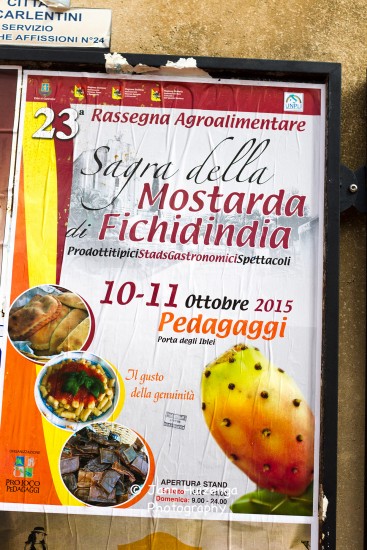 The sinister plants lined the roadway, the asphalt bloody with fallen fruit.
The sinister plants lined the roadway, the asphalt bloody with fallen fruit.
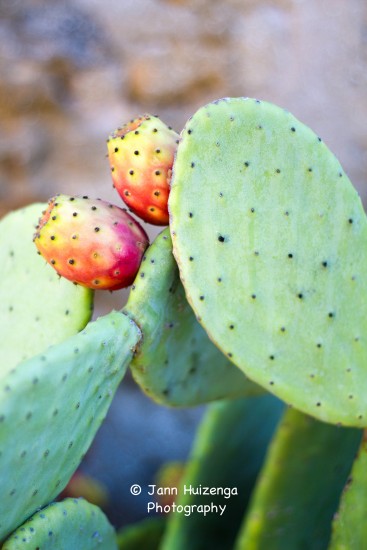 They paid homage to the fruit in the tiny town of Pedagaggi. They ate it fresh, candied, mashed into marmalade, and cooked into mostarda— something like prickly pear gummy bears. They drank it in liqueur.
They paid homage to the fruit in the tiny town of Pedagaggi. They ate it fresh, candied, mashed into marmalade, and cooked into mostarda— something like prickly pear gummy bears. They drank it in liqueur.
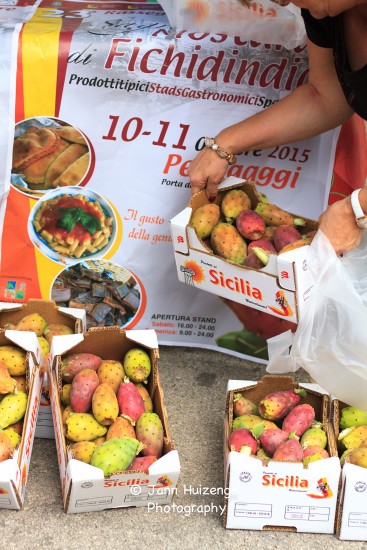 In my early innocent days on the island, I bought several of the fruits and blithely peeled them, glove-less. For days afterwards my fingertips prickled with pain, as I sat in the sun pulling out ultra-fine spines with a tweezers. I have shunned the fruit since.
In my early innocent days on the island, I bought several of the fruits and blithely peeled them, glove-less. For days afterwards my fingertips prickled with pain, as I sat in the sun pulling out ultra-fine spines with a tweezers. I have shunned the fruit since.
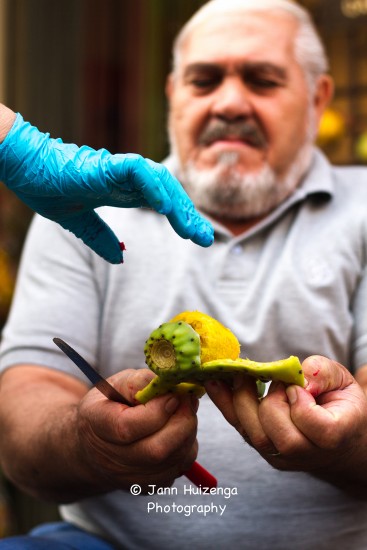 This bearded fellow explained that his hands are so calloused from the fields he has no need for gloves. But his wife came well-equipped. Every Sicilian has a story about American GIs in WWII, who plucked the fruit right off the plant and bit into it. This makes them laugh.
This bearded fellow explained that his hands are so calloused from the fields he has no need for gloves. But his wife came well-equipped. Every Sicilian has a story about American GIs in WWII, who plucked the fruit right off the plant and bit into it. This makes them laugh.
Food festivals in Sicily always attract a biker crowd, clad in old denim and black leather. They’re always the life of the party.
***
Click to subscribe to BaroqueSicily.
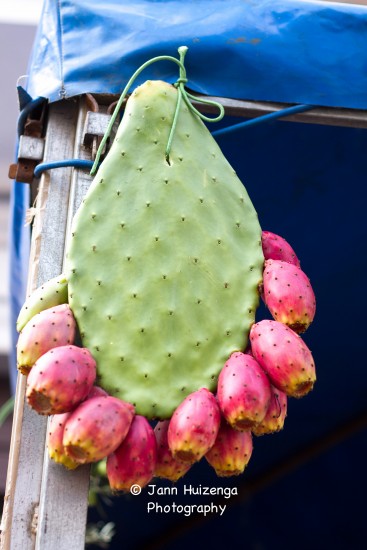

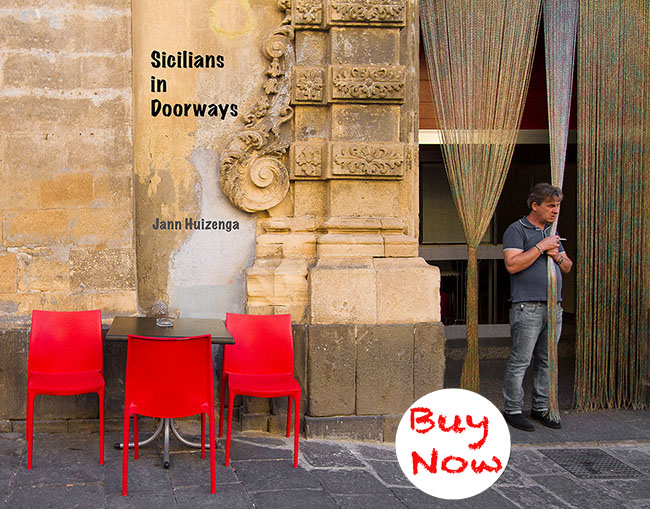

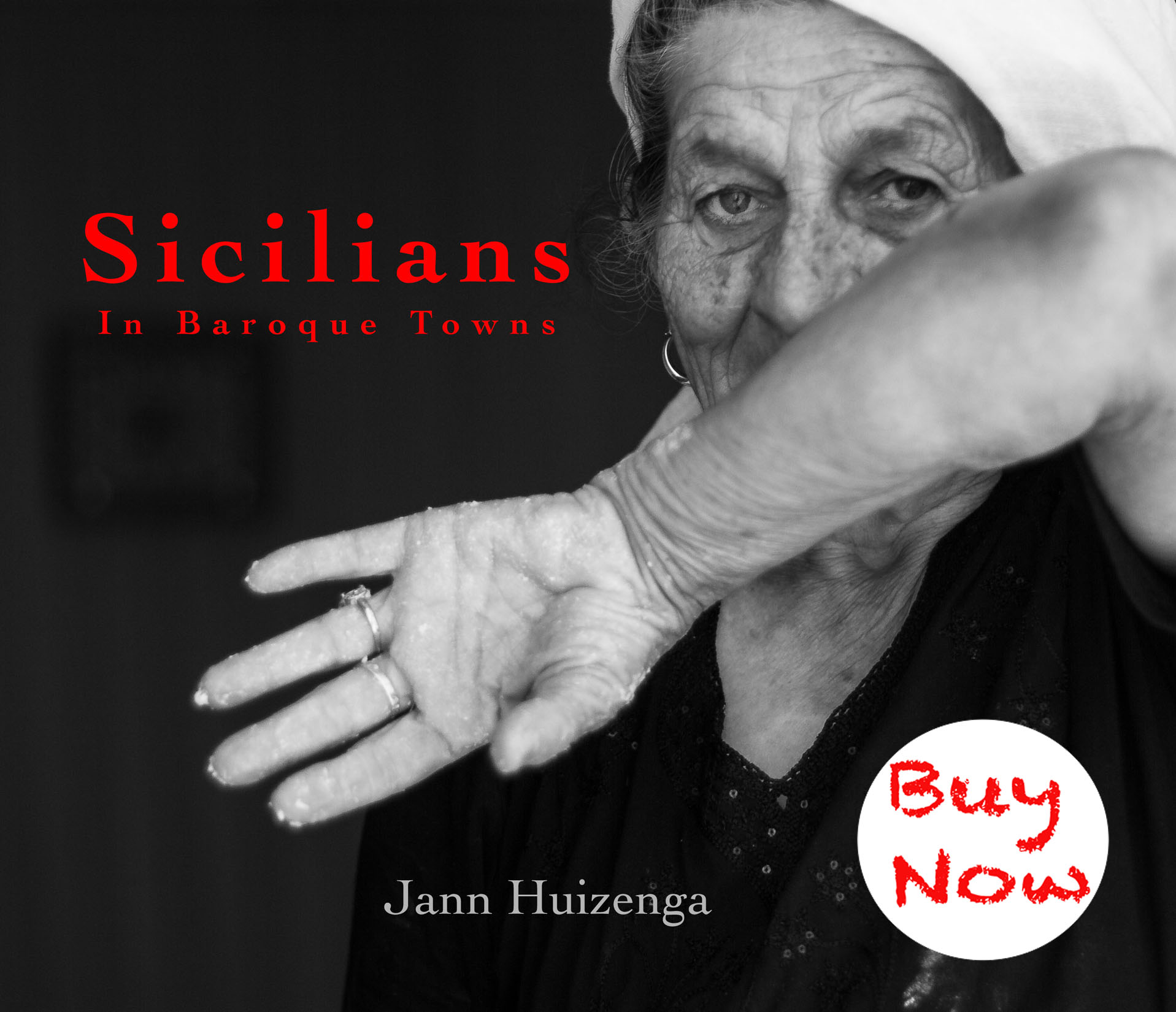


The best thing to do with fichidindia is leave it on the plant.
🙂 Buona idea, Chloe, at least for innocents abroad.
Hi Jann, Militello in Val Catania also has a Sagra around this time for the Ficodiindia. Lovely little town. Near Valguarnera Caropepe I see them being grown commercially and the ones I see in the store in our little town are senza spine. There is a tool that looks like a tin can with open ends and it cuts them off the plant. The tool is attached to a pole so you can keep your distance. I have them fall directly into a bucket of water, knock them around a bit and rinse several times. Pretty much gets rid of the spines and they are then much safer to peel!
Ciao Margaret–it’s great to hear from you!! Thanks very much for all this information; unfortunately I missed Militello’s sagra 🙁 but I’ll try for next year.
God must have said, “I shall create a strange, ugly, funky, interesting, thorny fruit now since I have a little time.”
He then created the prickly pear!
It is quite sinister and oh-so-cool!!
xxxxxxx kissssssssssssssssssssssssssssss
Kisses back to you from the land of funky fruit. xxxxx
In Palermo, after a treatment, I asked a patient “come me trova finora”. He responded “come fichidindia”
🙂 How funny Dennis! I guess he was suggesting a lighter touch–or were your fingernails too long?
yes,Jann Frankish referred to France at the very early use but then it referred to whole western Europe.
I see! Thanks for the clarification Cemal.
I guess they don’t call them “prickly pear” for nothing, huh, Jann?!? I’ve never had one — never even handled one — and your post here convinces me I’ve not missed much, ha!!
The liqueur is pretty good though! 🙂
The fruit of the cacti family, grown in Cyprus and The Mediterranean coasts of Turkey is called Frenk İnciri ( Frankish fig ), Hindu fig , Prickly fig ,Babutsa , and The tongue of the-mother-in law. It is sold by street sellers mostly because they are the masters of peeling them…These days there are efforts to produce them scientifically.
Hi Cemal–the “tongue of the mother-in-law”! Ouch. Here in Sicily, a certain kind of short round cactus is called “mother-in-law’s cushion.”
And Frankish fig–like from France?? Here it’s called FICHI D’INDIA, Indian fig. Thanks for commenting!
The giant prickly pear, one of many kinds native to the New World, is native to Mexico. It’s value as a food plant (both the fruit and young paddles) was known to the Native American Indians (pellerosse) and quickly adopted by the Spanish and transplanted back to Europe.
I was intrigued on my most recent visit to Bernini’s Fountain of the Four Rivers in Rome to notice that each of the four continents is represented not only by the colossal male figure, but also by an animal and a plant. So well known was it in southern Europe by 1650, that America is represented by this plant, Opuntia ficus-indica.
My husband picks the fruits of other types of cacti — carefully with tongs! — here in the Sonoran Desert to make into sweet jelly. Delighted, as always, to learn there is a festa around this fruit in Sicily.
I loved the anecdote about GIs picking and biting into the fruits. They grow in a very limited corner of the US and most people still have no first-hand experience with them even today. Thanks for sharing.
Hi Mark (Mark’s wife?)! Thanks for this great & informative comment. (I will have to look with a more careful eye at Bernini’s sculpture next time I’m in Rome). I bet your sweet prickly pear jelly is fabulous.
I meant to say 60 klicks, not 0. Mi scusi!
Thanks Don! Got it.
I remember seeing the fruit of the prickly pear (Fruit from India) cooked with starch and sugar, poured out into wicker-like flat baskets and set in the sun to dry. It was then rolled up and stored for use as candy in the Winter. This was in Polizzi Generosa, about 0 klicks from Palermo in the Madonie mountains. I also remember the spines in my hands when I thought it macho to handle the fruit without gloves!
Don, that winter candy is, I think, what they call prickly pear “mostarda” here. It’s chewy and reminds me of gummy bear candy. Thanks for your comment! I love Polizzi Generosa and the Madonie in general.
Great post Jann. Love the yarn about the American GIs.
Francesca–thanks for stopping by.
Ciao Jann, hope there some prickly pears when I get there, I remember there was a guy in back of the piazza that would skin them for a few lira’s, boy they were delicious, I well I can only hope.
Are you finding your prickly pears John???
My dad pronounced it “Figidini” for Fichi d’India, in Ragusan dialect.
Frutta deliziosa e sapurita! 🙂
Cute pronunciation, Robert. Haven’t heard that, but then people don’t use dialect with me–they know I wouldn’t understand a word.
Your bikers seem to be full of bonhomie – more like a traveling theater troupe than the kind of biker gangs we have in the U.S.
Exactly, Sam–that’s what this group was like.
I love when you highlight local festivals like this! The people area always smiling and having a good time and I always learn something new!! We have a similar cactus (without the fruit) that grows wild here in some fields and if you don’t keep the fields cut back, and you walk barefoot? Yikes!
Keep your shoes on Nan!
We were there sabato sera. Not a big fan of this fruit but they had so many good local products. We went to eat after at an amazing trattoria Cantina del Casale right in town.
Linda–sorry we missed you! We also saw that trattoria–sorry now that we didn’t try it.